Mary's blog
Developing that first idea
Sun, 18/08/2013 - 15:02 — MaryThis is the eighth of my blogs for www.writinghistoricalnovels.com a seried of blogs put together by Steve Rossiter of the Australian Literature Review
That first germ of an idea, the thread or theme which will run thr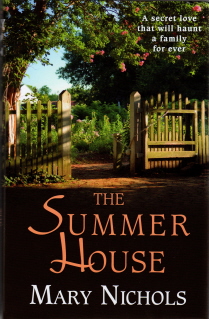 ough the book, can come from anywhere at any time: while reading, watching television, doing the housework or gardening, listening to other people’s conversations on a train or bus or from a story someone has told me. The trick is to recognise it when it does and grab hold of it. Some say you should write it down before it’s forgotten, but my theory is if it is so easily forgotten, then it wasn’t a particularly good idea. The really good ones stick.
ough the book, can come from anywhere at any time: while reading, watching television, doing the housework or gardening, listening to other people’s conversations on a train or bus or from a story someone has told me. The trick is to recognise it when it does and grab hold of it. Some say you should write it down before it’s forgotten, but my theory is if it is so easily forgotten, then it wasn’t a particularly good idea. The really good ones stick.
Just after the war my mother worked in a home for unmarried mothers. The girls (some of them very young) were taken there a few weeks before the birth to have their babies who were then taken away for adoption. A week or two later the mothers were sent home and expected to get on with their lives as if nothing had happened. My mother was often asked to take a newborn baby from the town where we lived to London on the train where she would meet another social worker at the station and hand the baby over to be taken on to the adopting mother. In that way, the real mother and the adoptive parent never met, never knew each other’s names, and the child grew up in ignorance of his or her roots. Unless of course, they were told they had been adopted when they grew old enough to understand. That tale stuck in my memory and only surfaced many years later when reading about someone looking for their birth mother. I couldn’t help wondering about the poor mothers and how they must have felt. Surely you could not forget the child you had carried for nine months and held in your arms as an infant? Could that be a basis for a story?
In the second world war having an illegitimate baby was a terrible disgrace and in the Great War its impact would have been even worse. It was then I applied the what if exercise to start the ball rolling. What if my mother-to-be was married to a serviceman away fighting France? What if she fell in love with someone else and he, too, was sent to France, leaving her pregnant? How would she feel? How would she cope? What if she was forced to put her baby up for adoption, how would she react? what would the adoptive parents be like? Rich or Poor? Why were they adopting? Would she be cared for and loved? Would she be told the story of her birth or would it be kept from her? How would she react when she found out? If the real mother does find her daughter again, how would she feel? What would she, could she, do about it? In answering these questions I had my story.
But the idea is only the beginning. I needed to put it in its historical setting and chose to have a prologue covering the birth of the baby at the end of the First World War, then switch to WW2, when the baby is an adult herself, for the main body of the story. Prologues are a good device if you need to cover something that happened years before. Sometimes you can do this by introducing the back story in snippets as you go along, but if it is really important, telling it as it happens gives it more punch.
The result was THE SUMMER HOUSE which shot to the top of the charts, much to my delight. It was also long listed for the Romantic Novelists Association Romantic Novel of the Year award 2010. It has been published in German and Polish and is soon to be published in Norwegian and Hungarian.
The Summer House is published by Allison and Busby. See my website www.marynichols.co.uk for more details.
A Weekend to remember
Sat, 27/07/2013 - 14:19 — MaryWriting is a lonely occupation. You can spend hours at the computer without speaking to a soul. Small wonder then that when a group of writers gets together, they talk. And talk. And if there are a couple of hundred voices all raised at once, the decibels hit the roof and bounce back again. They talk about the book that’s just been published, the one they are writing and the one yet to be written and still in the planning stage. They bounce ideas of each other, grumble about publishers and deadlines, ask for and receive advice.
The Romantic Novelists’ Association (RNA) exists for that very purpose. Its aim is to encourage new writers, support established authors and promote the romance genre, which has numerous sub-genres, all of which have a place in the Association. The membership ages range from very young to very old, mostly but not entirely female.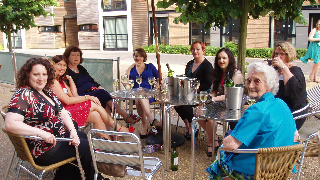
Each year there is a conference held on a university campus in vacation time. We become students again, sleeping in accommodation blocks, queuing up for food, hanging out in the kitchens drinking wine and making tea, and great fun it is. But there is a serious side. There are seminars, workshops, discussion groups, ideas exchanged and burning issues debated. For those who need them, interviews are arranged with publishers and agents. Books are bought and sold and mulled over.

This year we were at Sheffield in the Endcliffe Village. The organisation was, as always, superb. The company stimulating, the accommodation very good, the staff friendly and helpful. It was unfortunate that the air conditioning in the lecture rooms broke down on the hottest weekend of the year and we had to make do with numerous large fans. Some forward thinking members had brought their own fans as my picture illustrates. The long queues for meals stretched out of the dining room and into the scorching sun which had more than one of us skipping lunch in favour of a cuppa and a biscuit in the kitchens of our quarters which were blessedly cool. The kitchens were also the venue for parties in the evenings, when a surprising number of bottles of wine were drunk and various nibbles consumed with no thought for waistlines.
The highlight of the weekend is always a gala dinner when everyone dresses up and the tables are laid with shining cutlery and glass and we are served by smiling waiters and waitresses. Speeches are made and applauded, and the Elizabeth Goudge trophy presented.
All too soon another conference has come and gone and we return home rejuvenated, re-motivated, bursting with good ideas and looking forward to the next conference. In the meantime there is that novel to write.
The photgraphs are by kind permission of Annie Burrows.
Writing and selling historical novels
Sun, 21/07/2013 - 11:00 — Mary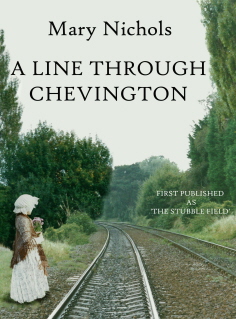 This is the sixth blog I have been writing for the Australian Literary review.
This is the sixth blog I have been writing for the Australian Literary review.
I am often asked where I get the inspiration for my books, but perhaps inspiration is not the most apt word. It is often a process of one thing leading to another. It might begin with something I’ve read, a tale someone has told me, a newspaper article or a TV programme which attracts my attention. I keep thinking about, adding to the original thread in my mind, discarding other threads, working on the plot and characters until it cries out to be written down.
One of the first novels I wrote was inspired by two books I had been reading: The Workhouse by Norman Longmate and The Railway Navvies by Terry Coleman. I didn’t read them specifically to use as a background but because I was interested in the subjects, but having read them I could see their potential.
Everyone dreaded the workhouse; I can remember my grandparents talking about it as something to be avoided at all costs. Life there was harsh, as it was meant to be. Families were separated in these institutions, husbands from wives, parents from children, brothers from sisters. In my book, orphaned brother and sister, Sarah Jane and Billie Winterday are forced to go to the workhouse when their parents die, where they are separated and from then on their lives follow completely different paths, although every now and again they are within a whisker of being reunited. Sarah Jane becomes involved with the navvies but she is ambitious and hers is a rags-to-riches story. Billie is a street urchin whose path is equally rocky, but he too grows in stature and ultimately finds success. I wrote the book through both points of view but I knew it was far, far too long and so I split it into two, dealing with Sarah Jane in the first book and Billie in the second.
The first one was turned down goodness knows how many times, though usually with a note saying where I had gone wrong. It is amazing the number of ways there are to go wrong and I must have used them all! As a result it was rewritten over and over again, but it was eventually published as The Stubble Field in 1993 by Orion (an imprint of Hachette) and did quite well.
Then I had one of those setbacks familiar to every writer. Although, according to my editor, Billie’s story was even better, it was turned down on the grounds that historical novels were out of fashion. No one was buying them. Certainly the publishers weren’t. I was stuck. No publisher would take a sequel to a book published elsewhere. Luckily for me Mills & Boon continued to publish my shorter historical romance novels and I kept going with them.Billie’s story languished in a drawer until I brought it out last year and published it as an ebook with the very able help of my daughter-in-law, entitled Promises and Pie Crusts.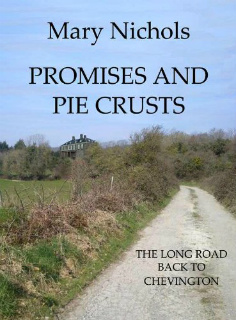
We did the same thing with the Stubble Field and renamed it A Line Through Chevington, so now they can now be bought and read together if you have an e-reading device. We did the same for The Poacher’s Daughter, with a background of the Captain Swing Riots of 1830, which was also originally published by Orion. Some of my early Mills & Boon books are out of print and I regained the rights to these and we converted them into ebooks too.
There is no telling how long or how successful the ebook phenomenon will be. It has its plus and minus side, but at the moment it is giving my out-of-print books a second airing and putting a little money into my pocket at the same time.
***
Using the Second World War as a setting
Tue, 04/06/2013 - 10:24 — MaryThis is the fifth of my blogs for the Australian literary review: http://www.writinghistoricalnovels.com/
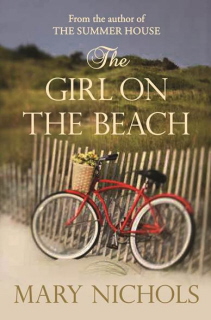 It always amazes me that the Second World War is considered history in the novel-writing sense because I am old enough to remember it, albeit through young, but impressionable eyes. I remember the blackout and the blitz, the rationing and shortages, the long queues and the black market and almost everyone in a uniform of one kind or another; army, navy, air force, police, Home Guard, Civil Defence, Women’s Voluntary Service, nurses, Boys’ Brigade, Boy Scouts, Girl Guides, all had their part to play.
It always amazes me that the Second World War is considered history in the novel-writing sense because I am old enough to remember it, albeit through young, but impressionable eyes. I remember the blackout and the blitz, the rationing and shortages, the long queues and the black market and almost everyone in a uniform of one kind or another; army, navy, air force, police, Home Guard, Civil Defence, Women’s Voluntary Service, nurses, Boys’ Brigade, Boy Scouts, Girl Guides, all had their part to play.
Private cars were not allowed to have petrol so you saw few of them. Shanks’ pony or a bicycle was the norm for getting to school or work, and the pony and trap came back into its own for local trips. Long journeys were almost always taken by train, which was often held up by air raids or having to go into a siding while an ammunition train was rushed through. There were no signposts on roads or names at railway stations; if you weren’t familiar with the route, you had to rely on the porter or other passengers to tell you when you had reached your destination.
London’s cityscape (and that of many other cities), changed day by day, as buildings and whole streets were destroyed. You were as likely to find yourself tripping over a hose snaking across the road or crunching broken glass underfoot as find a shop advertising ‘business as usual’ on its boarded up windows. I can’t hear the sound of a siren now without being hurled back into the past and feeling like a child again; it makes my heart beat uncomfortably fast. It was a time of great upheaval, not only of danger and hardship which was considerable, but changes in the way people lived, especially the women, who suddenly found themselves having to cope without their menfolk and coping unbelievably well. You learned to do jobs you never expected to have to do, you learned make food go a long way, to ‘make do and mend’, never to waste anything. It is a habit that those of us who lived through it can never break ourselves of. When it was all over, nothing would be ever be the same again.
It is a wonderfully fertile ground for novels. In the years immediately following it, people didn’t want to be reminded of it, they were more concerned with building a new world and that was never going to be easy, but before long books, true and fictional, started to come out and many of them have enjoyed a second life as films. Recently there has been a revival, not so much of the actual conflict, but stories of how people lived and coped.
If one of your characters is in London during an air raid it is as well to know which nights were particularly bad and where the damage was concentrated. And if someone is torpedoed, it is a good idea to know which ship they were on and the date she sank. If a soldier was lost in a particular battle then you need to know the date and circumstances even if you don’t write about the battle itself.
Writing about it has been no hardship for me, but that doesn’t mean I didn’t have to do any research; it is all too easy to get dates and the sequence of events wrong if you have to rely on memory. Memory plays tricks. Distances seemed longer then than now, possibly because we walked everywhere or rode bicycles. Working class people didn’t have telephones, not even my grandmother, who was a midwife and often called out in the middle of the night, (Usually the agitated father-to-be would throw a handful of grit at her bedroom window to rouse her.) so it would be wrong to have a labourer or a factory worker pick up a telephone to pass on some news. You need to know how long it would take for news to circulate, especially if it is something the BBC would not broadcast. Details like this need to be borne in mind when writing of the time. Or any time, come to that.
My books with a WW2 setting are: The Summer House, The Kirilov Star, The Girl on the Beach and Escape by Moonlight.
See www.marynichols.co.uk or www.allisonandbusby.com for more details
What makes a good Novel
Sat, 01/06/2013 - 11:06 — Mary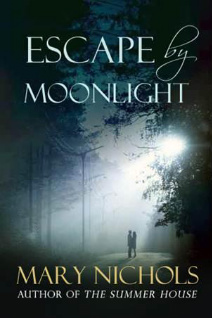
What makes a good Novel?
We often cogitate about what makes a good novel and there must be dozens of different answers according to our tastes. But here’s my answer. It would be interesting to learn how others define it.
I think there are four main ingredients to a good novel:
1. A page turning story with a satisfactory ending.
I like to think of the story as a string of beads. Each bead is a chapter/incident, attached to the one behind and the one before by the cord going through the middle of it, so that one leads to the next and at the end we use the clasp to join the end to the beginning to make a rounded whole. The beads do not need to be the same size; they can vary according to their importance in the scheme of things, but they should all have some significance in the way the story moves forward. If they don’t, they shouldn’t be there.
2. Believable characters the reader can identify with.
For me, the characters are the crux of the book. Their actions and reactions are what drives the story. The reader needs to be with them all the way, to identify with their problems, sympathise when they are down, share their joy when they are up, worry with them when fate turns against them, celebrate when things go right, feel their emotions with them. Even the bad characters. I don’t have really wicked characters in my books because I like to explore the reasons why they are bad and perhaps find some redeeming feature. Characters do not need to come to the book fully rounded, but grow and develop as the story progresses, so that at the end they have been subtly, or perhaps not-so-subtly, changed by their experiences.
My characters become so real to me that when I am writing their dialogue, I am listening to them talking and simply writing down what they are saying. Sometimes they say something I haven’t expected, and when I get to the end of the scene I find myself asking, ‘Now why did he/she say that?’ Nothing to do with me at all! If what they have said changes the way the story is going, then I have to make up my mind whether to rewrite the scene and force them back into line or go with the flow, because if they are acting in character (which they surely must be) they know best. I often find myself changing what happens next to accommodate them and sometimes even rewriting the synopsis!
3. The setting: When and where.
This is particularly important when writing historical novels. The setting and the period must be right for the story you want to tell and the problems the characters are going to encounter on their journey along that string of beads. Sometimes the idea for the story comes complete with its setting; it cries out to be a Regency, a Georgian or Victorian. Or it might lend itself best to a more modern setting. If I have a favourite period it is WW2, because I am old enough to remember it, though Regency and Victorian run close. It goes without saying the period must be well researched, even the times you have experienced yourself. The Summer House, The Kirilov Star, The Girl on the Beach and Escape by Moonlight published by Allison and Busby are second world war stories.
4. Good writing.
By good writing, I’m not talking about spelling, grammar and punctuation, that goes without saying. I mean writing that flows, so the reader is not conscious of it. It should have a cadence similar to poetry. The best way to tell if this has been achieved it to read it aloud. If you stumble over it, then it needs rewording. Readers don’t want to be pulled out of the story by a clumsy sentence or a meaning so vague they have to re-read it to make sense of it. To do this they have to abandon the story and that’s not good. I want them to reach the end with a sigh of satisfaction that all the characters’ problems have been resolved with no loose ends. That is story writing at its best.
There is a fifth requirement, which is largely out of the hands of the author, and that is good editing. A good editor will weed out inconsistencies, unintentional changes of name and place, mistakes in chronology, repetition, errors that an author is too close to the story to see. This is particularly important for anyone contemplating self-publishing.
And, of course, there is the cover which is also the domain of the publisher.
At the end of the day, the reader is the judge.
Doing the research
Sun, 21/04/2013 - 15:20 — MaryThis is the fourth of my blogs for the Australian literary review: Writing Historical novels. http://www.writinghistoricalnovels.com/
Historians will tell you to go to primary sources for your research and that, of course, is the ideal, but not always possible and, for the kind of books I write, not really necessary. I am not trying to educate my readers, though it is a plus if they learn something they didn’t previously know and it interests them. I want a believable and accurate background for a story.
Before the days of the Internet, it was done through books and it still is to a great extent. The shelves in my study are crammed with books I use for research.
First of all there is the invaluable Oxford English Dictionary and are those of general interest, used for background. There are social histories like Christopher Hibbert’s The English, A Social History 1066 - 1945; Asa Briggs’, A Social History of England, a much-thumbed penguin edition of Chronology of the Modern World 1763-1965 by Neville Williams, and Andrew Marr’s The Making of Modern Britain from Queen Victoria to VE Day and many more. There is the huge and almost unmanageable Chronicle of the 20th Century put together by Longman and, almost as big, The Chronicle of the Second World War. It is important to remember when using the latter or any similar book, that the date on which the event is recorded as happening is not necessarily the date on which it became known.
 Then there are several costume books. One I use a lot is Costume 1066-1966 by John Peacock, but there are many others. Knowing how people travelled is a must, so my shelves contain books about coaching, the different kinds of coach, how they were made, timetables and fares. Being particularly interested in railways which once covered the British Isles, all run by different companies, I have a big selection of those. And then there are books about sailing ships, how they were sailed and how long voyages took. There were explorers, pirates, ships deporting prisoners to America and Australia, besides war ships.
Then there are several costume books. One I use a lot is Costume 1066-1966 by John Peacock, but there are many others. Knowing how people travelled is a must, so my shelves contain books about coaching, the different kinds of coach, how they were made, timetables and fares. Being particularly interested in railways which once covered the British Isles, all run by different companies, I have a big selection of those. And then there are books about sailing ships, how they were sailed and how long voyages took. There were explorers, pirates, ships deporting prisoners to America and Australia, besides war ships.
Geography is another important area for research. The books I have in this category have all come about because of a particular story I wanted to write. Guide books are only marginally useful, contemporary travelogues are more helpful. You can get a feel of the geography of a place by visiting it, but the way a town looks now is unlikely to bear much resemblance to what it looked like a hundred or perhaps two hundred years ago, or even in our own lifetime, come to that. How many of us have gone back to the scene of our childhood and found ourselves unable to recognise any of it? It needs a leap of imagination to picture it as it was in the period we want to write about. I find contemporary pictures and maps much more helpful, although having said that, going to a place can give you a ‘feel’ of it and might tell you if a particular view you want to include would be feasible or not. It’s easier to stick to a countryside you are familiar with, which is why so many of my books are set in the English countryside and East Anglia in particular.
I use my local library a lot too, either to borrow books or read them on the premises and I have always found librarians very helpful in helping me to search out what I am looking for, even if it is only trying to discover when plaster of Paris was first used to set broken bones!
The Internet is now a great source of information too, but some of it needs taking with a good pinch of salt. It is not a good idea to use only one source, but to study several and if still in doubt, go back to books and authors you know you can trust. Sometimes I contact the originator of the site and ask questions and this seems to work with some. You soon come to realise if they know what they are talking about.
And we mustn’t forget fiction, particularly contemporary with the period you are writing about. Some of it is hard work, but worth it if it gives you a feel of the time in which it was written and the way people spoke. It is then I go to Jane Austen, Charles Dickens, or back to my library of classics.
Spring in the garden
Tue, 16/04/2013 - 17:36 — Mary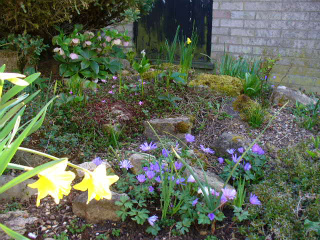 The spring-like weather we have had this last week has lured me into the garden. Everything is late this year. The daffodils are only just showing themselves, the phlox and aubretia have yet to show any colour and the tulips are still tight buds. But the hellebores and bergenia are putting on a brave show, as are the primulas and anemone blanda. And the erisimum isn’t far behind. I like that because, unlike its cousin the wallflower, it is a perennial and has a long flowering season. Above their heads the forsythia has suddenly become a golden shower against a pure blue sky. Perhaps we will have a spring and summer after all.
The spring-like weather we have had this last week has lured me into the garden. Everything is late this year. The daffodils are only just showing themselves, the phlox and aubretia have yet to show any colour and the tulips are still tight buds. But the hellebores and bergenia are putting on a brave show, as are the primulas and anemone blanda. And the erisimum isn’t far behind. I like that because, unlike its cousin the wallflower, it is a perennial and has a long flowering season. Above their heads the forsythia has suddenly become a golden shower against a pure blue sky. Perhaps we will have a spring and summer after all.
Usually my hanging baskets and pots are planted up by now, still under cover waiting for the last of the frosts before I put them out, but this year the plants are not big enough yet and I must wait a week or two longer. Will they catch up I wonder. I don’t have a greenhouse, but the geranium cuttings I took last autumn are growing strongly in their pots in the conservatory. I can’t put them out yet, either.
Even so, there is still plenty to do in the garden. I weeded everywhere last autumn, but a new crop has appeared as it always does and I spent a morning on my knees with a trowel, digging the little beggars out. I have spread some fertiliser and home-made compost as a mulch and given the grass a first cut
The summer perennials are coming out of the ground: peonies, delphiniums, lilies and poppies. The roses and clematis are showing their shoots too and that is enough to cheer anyone up. I don’t pretend to be a horticulturalist, but I love my garden which is a small one, but as much as I can comfortably manage. It’s where I go when I want a break from sitting at the computer. It never fails to lift my spirits, whatever the season, but especially in the spring and early summer.
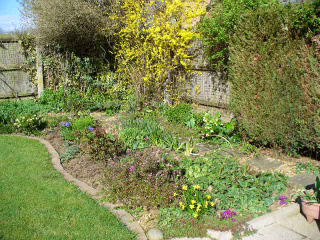
Dorothy Gurney wrote:
The kiss of the sun for pardon,
The song of the birds for mirth,
One is nearer God’s heart in a garden
Than anywhere else on earth.
Writing historical novels: getting the setting right.
Sun, 24/03/2013 - 11:24 — MaryThis is the third of my blogs to go on www.writinghistoricalnovels.com in which a group of writers of historical fiction write each month on the subject.
Getting the setting right is particularly important when writing historicals. The setting and period must be right for the story you are planning to tell and the problems and adventures the characters are going to encounter. Sometimes the idea for the story comes to me complete with its period; it could not be written around any other time, be it Regency, Georgian or Victorian. Or it might lend itself best to a twentieth century setting, whichever you choose, it needs to be established right from the word go, so the reader is in no doubt. It must be galling to think you are reading a Regency story only to find after half a dozen pages, it is Edwardian or Victorian, or even earlier.
Fashions, furnishings, means of transport and communication must be right for the period. You need to dress you characters correctly for their time and status, and what they ate and how often, should also be researched. The gargantuan appetites of the rich in Georgian and Regency times need to be set against the meagre rations of the poor.
If you are dealing with stage coaches, you need to know how long they took to get from A to B, how often the horses were changed and the route they were likely to follow and how much had to be laid out for fares, refreshments and overnight accommodation. The mail was more expensive than the stage and post chaise even more so and reserved for the very wealthy. You wouldn’t get on a train before the middle of the 19th century and even then it would be an innovation, or make a telephone call before the first world war and working class homes didn’t have them in the second world war either.
It is important to know how long news took to reach distant places, or if certain facts were withheld from the general public and your characters couldn’t have known them. If it is necessary for the story then you will have to invent a really good reason for how they came to know it. In my latest book, ESCAPE BY MONLIGHT, one of my characters is in occupied France during WW2 and I needed to find a way for her family in England to learn what she was up to. I did it by having her father working in Intelligence for the SOE (Special Operations Executive).
Taboos and morals, too, change over the years. What is right for one period would be frowned on in another; sex outside marriage and having babies, for instance. It went on, of course, - it always had - but the difference is in how it was dealt with. It was a disgrace in the 1930s and an even greater one in the era of the Great War, a point I made in my book THE SUMMER HOUSE. 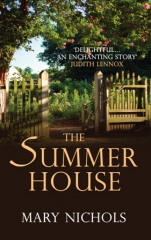
You need to know how crime was tackled too, how people were brought to court and the punishment they were likely to receive. And if you are writing about war, then you need to know the kind of weapons used and the uniforms of the protagonists, how the men lived when campaigning and how their womenfolk managed. Bernard Cornwell did it brilliantly in his Sharpe books. So did C S Forrester and Alexander Kent, aka Douglas Reeman.
Dialogue must reflect the times without becoming stilted. If we stuck slavishly to the way people spoke in Medieval times, for instance, it would become almost unreadable. You need to give a taste of the era in the way people speak but not overdo it. The same could be said of dialect; too much and it annoys the reader who has to puzzle what it means, too little and you loose the sense of locality. Slang must be used with caution because it is so volatile. Georgette Heyer used a lot of slang but it was part of the charm of her books. Whether it was always entirely accurate is another matter.
But however thorough the research, it is important not to give in to the temptation to put it into the book willy-nilly just to prove you know it. It should be like an iceberg; nine tenths below the surface, one tenth visible. It is there to put the period and surroundings into perspective. You use only what is necessary set the scene and take the story forward.
Writing novels set against an historical background
Mon, 11/03/2013 - 08:34 — Mary This is the second of my blogs on the Australian Review website: http://writinghistoricalnovels.com/2013/02/18/writing-novels-set-against...
This is the second of my blogs on the Australian Review website: http://writinghistoricalnovels.com/2013/02/18/writing-novels-set-against...
There are two kinds of historical novel: those in which the history is the main thrust of the book, featuring real events and real people, written by authors who are also historians, and those in which the history is the background to the story. It is the setting of the book, not its raison d’etre. I write the latter.
That’s not to say I take liberties with history. I will not, for instance, change the dates or sequence of events to accommodate my plot. The plot must fit the history, not the other way about, and that is part of the attraction of writing historical novels, slotting the two together into a believable whole. Nor do I use real people as my main characters, though they might appear as subsidiary characters. Even then their temperament and dialogue must be compatible with the kind of person they were known to be. Nor would I place them in situations where they would never be just to help my story along. When writing about the Napoleonic wars, I could hardly avoid mentioning Wellington, and I have occasionally given the Prince Regent a line or two of dialogue in my Regency novels.
I don’t know which comes first, the plot or the setting; it could be either or both together. Sometimes a story, by its very nature, cries out for a particular era or background - Medieval, Regency, Georgian or Victorian - or it could have happened at almost any time in history, human nature being what it is. The gamut of human emotions and motivations don’t change down the centuries, except in the way they are expressed. Taboos and morals, too, change over the years; what is right for one period would be frowned on in another. Some eras are more openly permissive than others, some more lawless. Poverty and wealth have always gone hand in hand, sometimes the poverty is stressed, sometimes the wealth. It is important not to give modern motives and reactions to historical characters.
Whatever era I choose to write about, I begin by reading. I collect and read dozens of books on the subject. I make no notes at this stage, simply absorb the ambience of the age, how people thought and felt, how they dressed, what they ate, how they travelled, how they communicated until I get a real feel for the times. Not until then do I plot my book and it is then I go back and research the particular events that I need to include. I make a time-line of real events and another of my plot and slot them together into one chronological list. Not until that is in place do I start to write.
That’s not to say it doesn’t go wrong on occasion - more frequently than I would like. My characters have a habit of doing their own thing. They are so real to me that when I am writing their dialogue, I am listening to them talking and simply writing down what they are saying. Sometimes they say something I haven’t expected, and when I get to the end of the scene I find myself asking, ‘Now why did he/she say that?’ Nothing to do with me at all!
If what they have said changes the way the story is going, then I have to make up my mind whether to rewrite the scene and force them back into line or go with the flow. I usually go with the flow because if they are speaking and acting in character, which they certainly ought to be, they surely know best. I often find myself changing what happens next to accommodate them and sometimes even rewriting some of the plot, and that’s not easy when you have a historical timeline to adhere to. But it’s all part of the challenge. It’s a funny thing but when it’s done and the book published, it’s impossible to tell that wasn’t always how it was meant to be. My characters have served me well.
Mothers' Day
Fri, 08/03/2013 - 07:46 — Mary Sunday will be Mother’s Day, when sons and daughters honour their mothers by giving them cards and presents. It was originally an American tradition, not the same as the Christian Mothering Sunday, although they have become synonymous.
Sunday will be Mother’s Day, when sons and daughters honour their mothers by giving them cards and presents. It was originally an American tradition, not the same as the Christian Mothering Sunday, although they have become synonymous.
Originally Christians returned to their ‘Mother’ Church on the fourth Sunday of Lent to worship together as a family. It was sometimes referred to as Refreshment Sunday because it provided a break from the rigours of Lenten fasting. This evolved into the day when young servants were given a day off to visit their mothers, when they would take flowers and simnel cake, baked by the lady of the house or, more often than not in a big house, by her cook. Simnel cake is a fruit cake layered with marzipan decorated with eleven marzipan eggs to signify the eleven months since the child was last at home. I remember my own mother saying she did this.
The practice died out in the nineteen thirties. It’s revival is attributed by some to the arrival of the American servicemen in the second world war. Surprised to discover we in England did not follow this tradition and to show their appreciation to the families who befriended them when they were so far from their own mothers, they brought them presents on that day. Not to be outdone, local children started doing it too, and so Mother’s Day, as we know it, was born.
I am sure others remember When God Made Mothers, written by Erma Bombeck.
By the time the Lord made mothers, he was into his sixth day of working overtime. An Angel appeared and said, ‘Why are you spending so much time on this one?’
The Lord answered, ‘Have you seen the spec sheet on her? She has to be completely washable but not plastic; have 200 hundred movable parts, all replaceable; run on black coffee and leftovers; have a lap that can hold three children at one time and that disappears when she stands up; have a kiss that can cure anything from a scraped knee to a broken heart, and have six pairs of hands.’
The angel was astounded at the requirements for this one. ‘Six pairs of hands! No way!’
The Lord replied, ‘Oh, it’s not the hands that are the problem, it’s the three pairs of eyes that mothers must have.’
‘And that’s just the standard model?’ the Angel asked.
The Lord nodded in agreement. ‘Yes. One pair of eyes to see through a closed door as she asks her children what they are doing even though she knows already. Another pair in the back of her head are to see what she needs to know even though no one thinks she can. And the third pair are here in front of her head. They are for looking at an errant child and saying that she understands and loves him or her without even saying a single word.’
The Angel tried to stop the Lord. ‘This is too much work for one day. Wait until tomorrow to finish.’
‘But I can’t,’ the Lord protested. ‘I am so close to finishing this creation that is so close to my own heart. She already heals herself when she is sick and can feed a family of six on a pound of mince and can get a nine-year-old to stand in the shower.’
The Angel moved closer and touched the woman. ‘But you have made her soft, Lord.’
‘Yes, she is soft,’ the Lord agreed. ‘But I have also made her tough. You have no idea what she can endure or accomplish.’
‘Will she be able to think?’ asked the inquisitive Angel.
The Lord smiled and replied, ‘Not only will she be able to think, she will be able to reason and negotiate.’
The Angel noticed something and reached out to touch the woman’s cheek. ‘Oops, it looks like you have a leak with this model. I told you, you were trying to put too much into this one.’
‘That is not a leak,’ the Lord objected. ‘That is a tear.’
‘What’s the tear for?’ the Angel asked.
The Lord said, ‘The tear is her way of expressing her joy, her sorrow, her disappointment, her pain, her loneliness, her grief and her pride.’
The Angel was impressed. ‘You are a genius, Lord. You thought of everything. You do all things well. Truly Mothers are amazing.’
Mothers are precious; we do not always appreciate them until they have gone from us. My own mother has been gone for many years but I still miss her.
